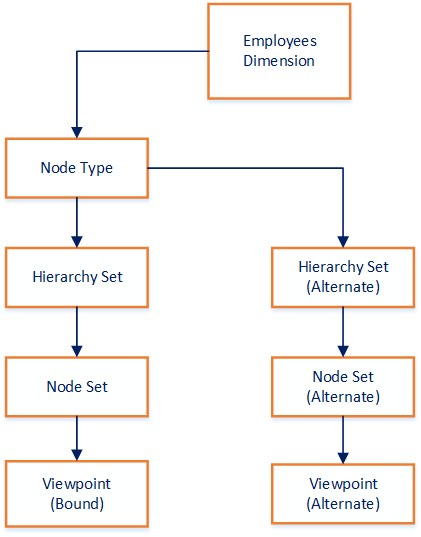Understanding Data Chains
A data chain is a series of related data objects. The nodes available to users in a viewpoint are defined by its data chain.
The configurations of objects on a data chain also define a viewpoint's available properties.
The data chain consists of the following data objects:
- Application: a business application serving a specific purpose such as Oracle Financials Cloud General Ledger or Planning which includes enterprise data to be managed.
- Dimension: a business dimension of an application such as Account, Entity, and Product.
- Node type: a type of enterprise data record in a dimension such as a General Ledger segment value, a Planning dimension member, or a General Ledger to Planning mapping. Each node type defines the characteristics of a record, which is called a node. A dimension can consist of one or more node types. Nodes and their properties are stored in a node type.
- Hierarchy Set: a set of hierarchy relationships between nodes of particular node types in a dimension. Each hierarchy set defines the node types which are related and the rules for hierarchies in that set. A hierarchy set can contain one or more Root Nodes which define the starting points for hierarchy relationships in the set. Relationships and their properties are stored in a hierarchy set.
- Node Set: a set of nodes in a dimension which has a particular structure such as a List or a Hierarchy. A list node set can consist of one or more node types in a flat list. A hierarchy node set can consist of a hierarchy set and one or more top nodes. A top node of a node set can be a root node from the hierarchy set or a descendant of a root node.
- Viewpoint: a business perspective of a dimension used for a particular purpose such as viewing a list of accounts or managing a product hierarchy or exporting an entity structure. Viewpoints are organized into one or more views. Each viewpoint uses a node set and controls how users work with data in that node set in a specific view.
- Dimension: a business dimension of an application such as Account, Entity, and Product.
- View: a group of viewpoints used for a particular purpose, such as managing data for a dimension across applications or integrating data from and to an external system. Each application uses a default view to import and export enterprise data. Each viewpoint in the default view represents the data as it exists in the external system. Users can define additional views of their own to view and manage data for specific business purposes.
Note:
If you are familiar with relational database concepts, node types and hierarchy sets are similar to database tables in that they hold data, node sets are similar to database predicates or "Where" clauses in that they select the nodes that you want to work with, and viewpoints are similar to database views in that they provide the user interface in which users work with data.Data objects are modular; node types, hierarchy sets, and node sets can be used in multiple data chains. The data objects have the following relationships:
- A node type is used by one or more hierarchy sets or node sets.
- A hierarchy set uses one or more node types.
- A hierarchy set is used by one or more node sets.
- A node set uses one hierarchy set.
- A node set for a list uses one or more node types.
Note:
If a node set uses a hierarchy set, the node types are inherited from the hierarchy set. - A node set is used by one or more viewpoints.
- A viewpoint set uses one node set.
Dimension with Multiple Data Chains Example
To understand the relationship of dimensions and data objects, consider the following example:
- The user is working with an Employees dimension and needs to create an alternate viewpoint that models the results of a reorganization.
- To create the viewpoint for the alternate viewpoint, the user performs the following steps:
- Reuse the node type that was used in the data chain of the bound viewpoint.
- Create a new hierarchy set that references the node type.
- Create a new node set that references the hierarchy set.
The data objects used in both data chains are assigned to the Employees dimension, as shown in the following diagram:

Note:
The alternate viewpoint and its hierarchy set and node set are not bound to a dimension, and thus are not required to conform with the dimension's binding rules. The node type in this example complies with the dimension's binding rules even though it is part of the alternate viewpoint's viewpoint. This is because the node type is also part of the bound viewpoint's data chain.For more information, see: